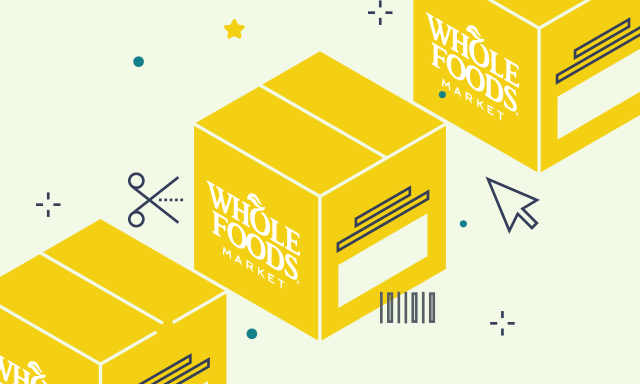

 Article
Article

 In 2017, Amazon announced it would acquire Whole Foods, and the company paid $13.2 billion for the deal, about $9 billion more than the grocery chain's fair market value. Will this ultimately mean a massive write down in value for the tech giant or a savvy investment?
In 2017, Amazon announced it would acquire Whole Foods, and the company paid $13.2 billion for the deal, about $9 billion more than the grocery chain's fair market value. Will this ultimately mean a massive write down in value for the tech giant or a savvy investment?

How will Amazon’s acquisition of Whole Foods — a strong brand whose momentum faltered in recent years — play out in stores and on the balance sheet?
In June 2017, Amazon announced it would acquire Whole Foods, 2016’s seventh largest grocery chain in the U.S. and the dominant organic/natural brand, for $42 per share.
Whole Foods was faltering as Amazon closed in on a decade of experimenting with its own food business. The Internet giant was successfully selling a vast array of merchandise online, but its grocery delivery service, AmazonFresh, remained a much smaller business. By buying Whole Foods, Amazon gained 470 stores and a real stake in the $600 billion grocery market.
But Amazon paid a hefty premium for these advantages. From 2012 to 2017, Whole Foods’ annual growth rate had plummeted from 15.7 percent to 1.9 percent, while store sales, profits and stock price also dropped. The $13.2 billion Amazon paid for Whole Foods was significantly higher than the fair market value of its net assets, making nearly 70 percent of the deal goodwill — a big bet that future synergies would generate value from assets not on the Whole Foods balance sheet.
After the acquisition, Whole Foods continued to struggle. In February 2018, plagued by inventory management problems, it lowered its sales forecast and announced it would close stores.
For its part, Amazon has not instituted radical change at Whole Foods. In some Whole Foods stores, Amazon has expanded grocery delivery services and added merchandise pickup centers and kiosks selling Amazon gadgets. In February, in a long-anticipated move, Amazon began offering discounts at Whole Foods to its Amazon Prime Rewards Visa cardholders.
Amazon saw nearly $178 billion in annual revenue in 2017. The company sells nearly everything to maintain a household — apart from food, cars and health care. It’s chosen to go after food and, with $9 billion worth of Whole Foods related goodwill sitting on the Amazon consolidated balance sheet, it’s a bet the company needs to make pay off.
The fundamentals show promise. Only 12 percent of U.S. consumers bought their groceries online in 2016, so the opportunity is vast. Further, millennials, the largest group to use online grocery shopping, are loyal to both Amazon and Whole Foods. Combining a loyal customer base open to online shopping with the technology Amazon.com could offer, and with Whole Foods stores as potential delivery hubs, the opportunity to lead and excel in online grocery shopping is there.
But there are reasons for caution, too. Paying this kind of premium is unusual in the grocery sector, and Whole Foods needs to regain its footing. Other deals that have come bloated with goodwill — Microsoft’s purchase of Nokia, the AOL/Time Warner merger and, most recently, General Electric’s Power segment, for instance — have ended in the acquiring company taking massive write downs in value. Will Amazon be taking that step in future, or is it on its way to becoming one of the world’s largest food sellers?
This article is based on the case Amazon.com Inc. Buys Whole Foods Market (Darden Business Publishing), by Luann J. Lynch and Mark E. Haskins.
Lynch’s expertise and research interests are primarily in how to best pay or otherwise give incentives to bosses that will make their companies succeed. The focus of her work can be broadly characterized as an exploration of how incentives and compensation systems are structured to encourage the desired behavior by the individuals or organizations. Her work has examined incentive issues such as stock options, compensation in post-merger integration efforts and the effect of financial reporting, accounting and regulation on incentive compensation.
Before joining the Darden faculty, Lynch was assistant vice president at Roche Biomedical Laboratories Inc. and held positions in finance and accounting at Roche, Northern Telecom (NorTel) and Procter & Gamble.
Lynch is author and co-author of several articles published in leading accounting and finance journals.
B.S., Meredith College; MBA, Duke University; Ph.D., University of North Carolina
Haskins is an expert in the fields of performance management/measurement, corporate financial reporting, talent development and the design of effective learning experiences.
He has written extensively on these subjects and has taught Executive Education programs in these areas for global audiences at such companies as: AES Corporation, IBM, INTELSAT, MCI, Coopers & Lybrand, Aetna Insurance, Norfolk Southern Railroad, Messer Grieshem, Rolls Royce NA, Air Liquide America, MassMutual, Harris Corporation, the U.S. Navy and the U.S. Air Force.
Haskins is also author of the The Secret Language of Financial Reports and co-author of Teaching Management: A Field Guide for Professors, Consultants and Corporate Trainers.
B.B.A., University of Cincinnati; MBA, Ohio University; Ph.D., Pennsylvania State University